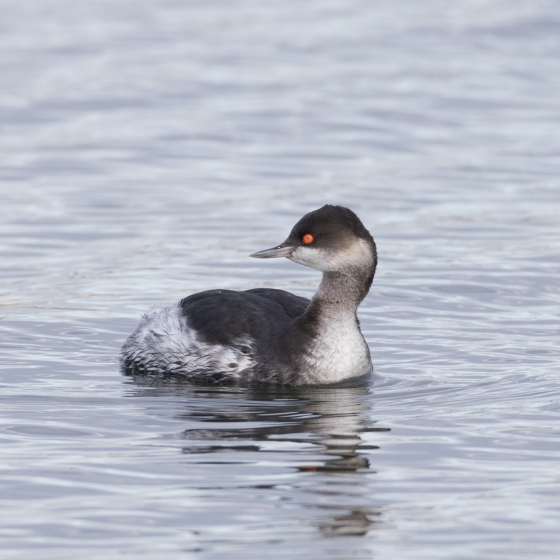Black-necked Grebe

Introduction
Black-necked Grebe is a rare breeding species in Britain, its small population largely restricted to central and eastern England. During the winter months the species may be found more widely on both inland and coastal sites.
Breeding Black-necked Grebes appear to favour shallow eutrophic lakes and pools with an abundance of submerged and floating vegetation. Favoured sites are typically quiet and undisturbed, and the species can be secretive when breeding.
The numbers of wintering Black-necked Grebes suggests that our breeding population is joined by individuals from elsewhere during the winter months.

Key Stats
Identification
ID Videos
This section features BTO training videos headlining this species, or featuring it as a potential confusion species.
Winter Grebes
Small Breeding Grebes
Songs and Calls
Call:
Begging call:
Status and Trends
Conservation Status
Population Change
The first UK breeding record of Black-necked Grebe was in 1904, and breeding numbers remaining very low for most of the twentieth century (Martin & Smith 2007). The population trend has been stable over the 25 years to 2019 (Eaton et al. 2021), having risen between the 1970s and the early 1990s (Martin & Smith 2007). The species has a scattered and localised breeding population in the UK and is monitored by the RBBP with a five-year mean of 53 breeding pairs over the period 2015–2019, almost all in England (Eaton et al. 2021).
Distribution
Black-necked Grebes prefers sheltered coastal waters and large open reservoirs in winter. In winter they most abundant around the Thames Estuary and along the south coast of England. They are very scarce breeders in the UK, with most pairs in central and eastern England.
Occupied 10-km squares in UK
or view it on Bird Atlas Mapstore.
or view it on Bird Atlas Mapstore.
European Distribution Map
Distribution Change
Black-necked Grebes have become more widespread in winter and the breeding season, although there have been losses in Scotland.
Change in occupied 10-km squares in the UK
or view it on Bird Atlas Mapstore.
or view it on Bird Atlas Mapstore.
Seasonality
Black-necked Grebes are present year-round though always scarce, and slightly more likely to be seen in winter.
Weekly pattern of occurrence
The graph shows when the species is present in the UK, with taller bars indicating a higher likelihood of encountering the species in appropriate regions and habitats.

Movement
Britain & Ireland movement
Foreign locations of birds ringed or recovered in Britain & Ireland
Dots show the foreign destinations of birds ringed in Britain & Ireland, and the origins of birds ringed overseas that were subsequently recaptured, resighted or found dead in Britain & Ireland. Dot colours indicate the time of year that the species was present at the location.
- Winter (Nov-Feb)
- Spring (Mar-Apr)
- Summer (May-Jul)
- Autumn (Aug-Oct)

European movements
EuroBirdPortal uses birdwatcher's records, such as those logged in BirdTrack to map the flows of birds as they arrive and depart Europe. See maps for this species here.
The Eurasian-African Migration Atlas shows movements of individual birds ringed or recovered in Europe. See maps for this species here.
Biology
Productivity and Nesting
Nesting timing
Egg measurements
Clutch Size
Fledging
Survival and Longevity
Survival is shown as the proportion of birds surviving from one year to the next and is derived from bird ringing data. It can also be used to estimate how long birds typically live.
View number ringed each year in the Online Ringing Report.
lifespan
Biometrics
Wing length and body weights are from live birds (source).
Ring Size
Classification, names and codes
Classification and Codes
- Order: Podicipediformes
- Family: Podicipedidae
- Scientific name: Podiceps nigricollis
- Authority: CL Brehm, 1831
- BTO 2-letter code: BN
- BTO 5-letter code: BLNGR
- Euring code number: 120
Alternate species names
- Catalan: cabussó collnegre
- Czech: potápka cernokrká
- Danish: Sorthalset Lappedykker
- Dutch: Geoorde Fuut
- Estonian: mustkael-pütt
- Finnish: mustakaulauikku
- French: Grèbe à cou noir
- Gaelic: Gobhlachan-dubh
- German: Schwarzhalstaucher
- Hungarian: feketenyakú vöcsök
- Icelandic: Stargoði
- Irish: Foitheach Píbdhubh
- Italian: Svasso piccolo
- Latvian: melnkakla dukuris
- Lithuanian: juodakaklis kragas
- Norwegian: Svarthalsdykker
- Polish: (perkoz) zausznik
- Portuguese: cagarraz
- Slovak: potápka ciernokrká
- Slovenian: crnovrati ponirek
- Spanish: Zampullín cuellinegro
- Swedish: svarthalsad dopping
- Welsh: Gwyach Yddfddu
Research
Causes of Change and Solutions
Causes of change
The increases in the UK in the 1970s and 1980s are believed to be related to a general increase across north-west Europe (Martin & Smith 2007). However, the reasons for the increases are unclear.

